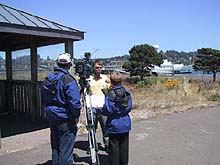
Waldo Wakefield, co-chief scientist of the Lewis and Clark Legacy Expedition, gives a press interview following the expedition. Click image for larger view.
Ocean Explorers Reveal Mysteries of the Astoria Canyon at the Hatfield Marine Science Center
July 13, 2001
Brady Phillips
NOAA Public Affairs
The NOAA vessel Ronald H. Brown returned to Newport, Oregon on July 12 after completing an 18-day mission to explore the secrets of Astoria Canyon and Heceta Bank. On July 13, NOAA's Office of Exploration, working with staff from the Hatfield Marine Science Center, organized a press conference to help generate awareness of this mission and the importance of ocean exploration. About 75 people attended the briefing, including local, regional and national media. A panel of scientists and dignitaries heralded the successes of the mission and discussed the continued need to explore these and other areas of the oceans. Panelists included:
- Paul Risser, President, Oregon State University
- Mark Abbott, Dean, College of Oceanic and Atmospheric Science, Oregon State University
- Usha Varanasi, Director, Northwest Fisheries Science Center
- Ed Bernard, Director, NOAA Pacific Marine Environmental Laboratory
- Steve Hammond, Chief Scientist, NOAA Office of Exploration
- Waldo Wakefield, Research Fisheries Biologist, NOAA Northwest Fisheries Science Center and Co-Chief Scientist of the Mission
- Bob Embley, Marine Geologist and Geophysicist, NOAA Pacific Marine Environmental Laboratory and Co-Chief Scientist of the Mission
Though it will take months to analyze and interpret all the data collected during the exploration, the panelists highlighted some new insights about these complex systems.
Using data from sidescan and multi-beam sonars, scientists unveiled new 3-dimensional, high-resolution images of the canyon that clearly depict features such as walls, sea floor, outcrops, faults, and slides. The research team used this map to focus and conduct comprehensive biological, chemical, physical and geological surveys of prominent canyon features using a variety of remote sensing and sampling devices and a sophisticated remotely operated vehicle with high resolution video from Canada named ROPOS (Remotely Operated Platform for Ocean Science).
Scientists are now piecing together the puzzle as to how the geological structure of the canyon and currents influence the distribution, diversity and abundance of biological life. Each area of the canyon that was explored revealed different types and amounts of invertebrates and fish. At one of the deepest parts of the canyon, researchers observed the seafloor teeming with bivalves, sea fans, black corals, anemones, skates and deep-water sole.
Geologists were also excited to find a section of the canyon wall where a recent landslide revealed many layers of undisturbed sediments deposited over thousands of years. Core samples taken at this site will help scientists reconstruct the frequency of past earthquakes and volcanic activity, and provide insight into predicting future events. Close to the continental shelf the research team recovered mussel shells, providing further evidence that this area was an ancient shoreline during the last ice age over 17,000 years ago when the sea level was lower.
After exploring the Astoria Canyon, the expedition ventured south along the Oregon coast to map and supplement ongoing National Marine Fishery Service groundfish monitoring efforts at Heceta Bank, an important commercial fishing ground. Researchers are trying to compare various habitats and fish and invertebrate populations at specific locations along the west coast. Exploration of Heceta Bank revealed numerous cold water seep habitats. These unique habitats are formed when methane or hydrogen sulfide gas seeps up through sediments. Chemosynthetic bacteria are able to convert these chemicals into energy. The bacteria fuel a diverse habitat comprised of tube works, clams, crabs and fish.
Immediately following the briefing, scientists participating in the mission conducted interviews and answered specific questions for the press. In the end, stories were filed about the mission in the following media:
Washington Post (Washington, DC), Associated Press, Discovery Channel News, Oregonian (Portland, OR), Eugene Register Guard (Eugene, OR), Tacoma News Tribune (Tacoma, WA), Newport News Times (Newport, OR), Lincoln City News Guard (Lincoln City, OR), KOIN Portland (CBS-TV), KEZI Eugene (ABC-TV), ABC News, and radio stations from Portland, Eugene and Newport.
The Ronald H. Brown was opened to the public from 1:00 – 4:00 PM for tours. About 400 curious residents visited the ship and were able to talk to various NOAA staff and researchers about the ship, the monitoring equipment on board, and various aspects of the mission. The Ronald H. Brown was by far the largest ship in port and became the talk of the town during its brief stay before heading back to continue its research mission at Heceta Bank.
Sign up for the Ocean Explorer E-mail Update List.





























